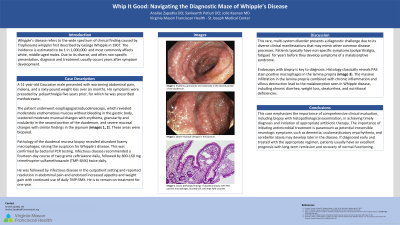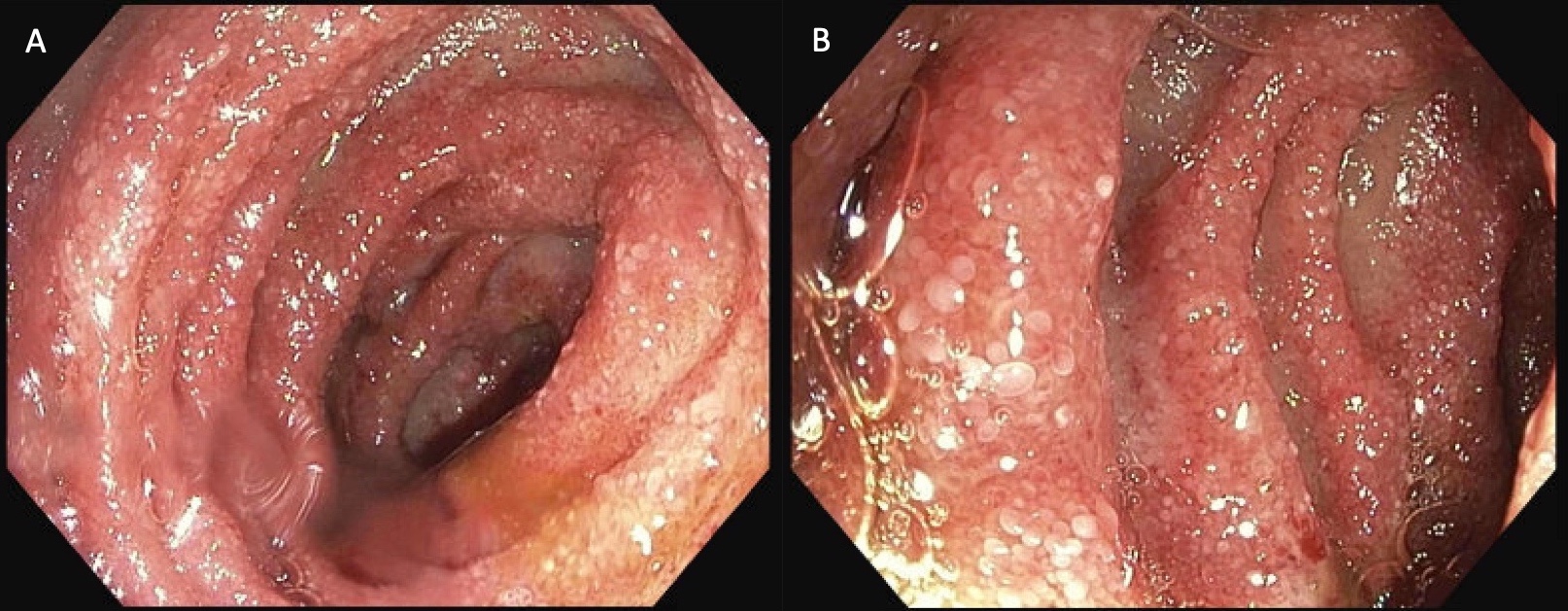Monday Poster Session
Category: Small Intestine
P3236 - Whip It Good: Navigating the Diagnostic Maze of Whipple's Disease
Monday, October 28, 2024
10:30 AM - 4:00 PM ET
Location: Exhibit Hall E

Has Audio

Analise Zapadka, DO
Virginia Mason Franciscan Health
Tacoma, WA
Presenting Author(s)
Analise Zapadka, DO, Sankeerth Potluri, DO, Jolie Keenan, MD
Virginia Mason Franciscan Health, Tacoma, WA
Introduction: Whipple’s disease refers to the wide spectrum of clinical findings caused by Tropheryma whipplei. This rare, multi-system disorder presents a diagnostic challenge due to its diverse clinical manifestations and low prevalence, with one study estimating prevalence in the United States to be 9.8 in 1 million people. The insidious and oftentimes protean presentation of Whipple’s disease contributes to its diagnostic complexity.
Case Description/Methods: A 51-year-old male presented to the emergency department with worsening abdominal pain and reported melena. The patient's symptoms started with polyarthralgia five years prior to presentation, for which he was prescribed methotrexate. He noted a sixty-pound weight loss over a six month period, which was later accompanied by abdominal pain and irregular bowel habits. On physical examination, his abdomen was diffusely tender to light and deep palpation with hyperactive bowel sounds. Abdominal computed tomography revealed mesenteric lymphadenopathy up to 1.4 cm with significant small bowel wall thickening. Esophagogastroduodenoscopy revealed moderately erythematous mucosa without bleeding in the gastric body, scattered moderate mucosal changes with erythema, granularity, and nodularity in the second portion of the duodenum and severe mucosal changes with similar findings in the distal duodenum. Pathology of the duodenal mucosa biopsies revealed abundant foamy macrophages, raising the suspicion for Whipple’s disease, and later confirmed by bacterial PCR testing. Infectious disease was consulted and recommended a fourteen-day course of two grams ceftriaxone daily, followed by 800-160 mg trimethoprim-sulfamethoxazole (TMP-SMX) twice daily. He was followed closely in the outpatient infectious disease clinic. He reported resolution in abdominal pain and endorsed increased appetite and weight gain with continued use of daily TMP-SMX. Per infectious disease, he will continue this regimen for at least one year.
Discussion: This case emphasizes the importance of comprehensive clinical evaluation, including histopathological examination, in achieving timely diagnosis and initiation of appropriate antibiotic therapy. The importance of initiating antimicrobial treatment is paramount as potential irreversible neurologic symptoms such as dementia, oculomasticatory myorhythmia, and cerebellar ataxia may develop later in the disease. Although rare, Whipple’s disease should be considered in patients with concomitant arthralgia, diarrhea, abdominal pain and weight loss.

Disclosures:
Analise Zapadka, DO, Sankeerth Potluri, DO, Jolie Keenan, MD. P3236 - Whip It Good: Navigating the Diagnostic Maze of Whipple's Disease, ACG 2024 Annual Scientific Meeting Abstracts. Philadelphia, PA: American College of Gastroenterology.
Virginia Mason Franciscan Health, Tacoma, WA
Introduction: Whipple’s disease refers to the wide spectrum of clinical findings caused by Tropheryma whipplei. This rare, multi-system disorder presents a diagnostic challenge due to its diverse clinical manifestations and low prevalence, with one study estimating prevalence in the United States to be 9.8 in 1 million people. The insidious and oftentimes protean presentation of Whipple’s disease contributes to its diagnostic complexity.
Case Description/Methods: A 51-year-old male presented to the emergency department with worsening abdominal pain and reported melena. The patient's symptoms started with polyarthralgia five years prior to presentation, for which he was prescribed methotrexate. He noted a sixty-pound weight loss over a six month period, which was later accompanied by abdominal pain and irregular bowel habits. On physical examination, his abdomen was diffusely tender to light and deep palpation with hyperactive bowel sounds. Abdominal computed tomography revealed mesenteric lymphadenopathy up to 1.4 cm with significant small bowel wall thickening. Esophagogastroduodenoscopy revealed moderately erythematous mucosa without bleeding in the gastric body, scattered moderate mucosal changes with erythema, granularity, and nodularity in the second portion of the duodenum and severe mucosal changes with similar findings in the distal duodenum. Pathology of the duodenal mucosa biopsies revealed abundant foamy macrophages, raising the suspicion for Whipple’s disease, and later confirmed by bacterial PCR testing. Infectious disease was consulted and recommended a fourteen-day course of two grams ceftriaxone daily, followed by 800-160 mg trimethoprim-sulfamethoxazole (TMP-SMX) twice daily. He was followed closely in the outpatient infectious disease clinic. He reported resolution in abdominal pain and endorsed increased appetite and weight gain with continued use of daily TMP-SMX. Per infectious disease, he will continue this regimen for at least one year.
Discussion: This case emphasizes the importance of comprehensive clinical evaluation, including histopathological examination, in achieving timely diagnosis and initiation of appropriate antibiotic therapy. The importance of initiating antimicrobial treatment is paramount as potential irreversible neurologic symptoms such as dementia, oculomasticatory myorhythmia, and cerebellar ataxia may develop later in the disease. Although rare, Whipple’s disease should be considered in patients with concomitant arthralgia, diarrhea, abdominal pain and weight loss.

Figure: Image A. Mucosal changes seen in the second portion of the duodenum
Image B. Mucosal changes seen in the fourth portion of the duodenum
Image B. Mucosal changes seen in the fourth portion of the duodenum
Disclosures:
Analise Zapadka indicated no relevant financial relationships.
Sankeerth Potluri indicated no relevant financial relationships.
Jolie Keenan indicated no relevant financial relationships.
Analise Zapadka, DO, Sankeerth Potluri, DO, Jolie Keenan, MD. P3236 - Whip It Good: Navigating the Diagnostic Maze of Whipple's Disease, ACG 2024 Annual Scientific Meeting Abstracts. Philadelphia, PA: American College of Gastroenterology.

